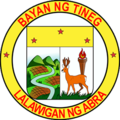Tineg | |
|---|---|
| Municipality of Tineg | |
 Map of Abra with Tineg highlighted | |
 Interactive map of Tineg | |
Location within the Philippines | |
| Coordinates: 17°47′N120°56′E / 17.78°N 120.94°E | |
| Country | Philippines |
| Region | Cordillera Administrative Region |
| Province | Abra |
| District | Lone district |
| Barangays | 10 (see Barangays) |
| Government | |
| • Type | Sangguniang Bayan |
| • Mayor | Edwin B. Crisologo Sr. |
| • Vice Mayor | Corinthia "Coring" D. Crisologo |
| • Representative | Joseph Bernos |
| • Municipal Council | Members |
| • Electorate | 3,074 voters (2025) |
| Area | |
• Total | 744.8 km2 (287.6 sq mi) |
| Elevation | 835 m (2,740 ft) |
| Highest elevation | 1,562 m (5,125 ft) |
| Lowest elevation | 421 m (1,381 ft) |
| Population (2024 census) [3] | |
• Total | 5,059 |
| • Density | 6.792/km2 (17.59/sq mi) |
| • Households | 875 |
| Economy | |
| • Income class | 2nd municipal income class |
| • Poverty incidence | 19.82 |
| • Revenue | ₱ 304.9 million (2022) |
| • Assets | ₱ 936.9 million (2022) |
| • Expenditure | ₱ 165.4 million (2022) |
| • Liabilities | ₱ 129.9 million (2022) |
| Service provider | |
| • Electricity | Abra Electric Cooperative (ABRECO) |
| Time zone | UTC+8 (PST) |
| ZIP code | 2822 |
| PSGC | |
| IDD : area code | +63 (0)74 |
| Native languages | Isnag Itneg Ilocano Tagalog |
Tineg, officially the Municipality of Tineg (Ilocano : Ili ti Tineg; Adasen : Ili niye Tineg; Tagalog : Bayan ng Tineg), is a municipality in the province of Abra, Philippines. According to the 2024 census, it has a population of 5,059 people. [5]


